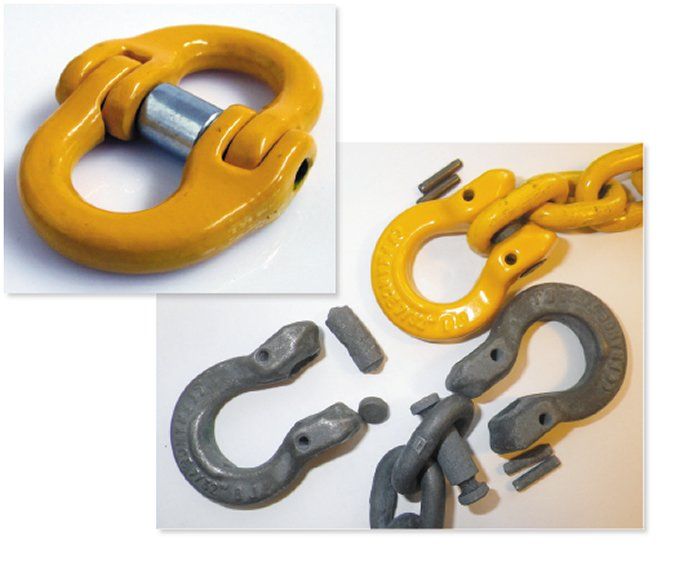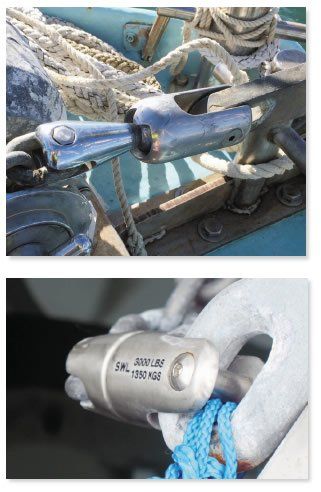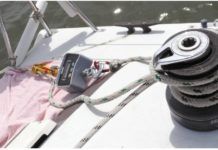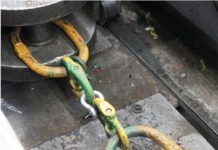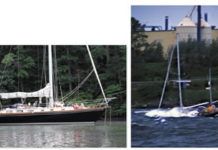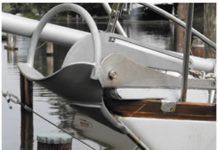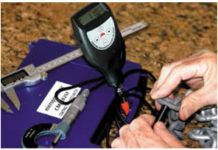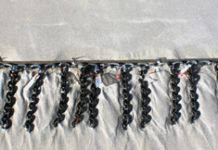Testing the Effects of Chain Hooks
During our research, nearly every maker of industrial chain offered the same caution: Using a generic chain hook can reduce the link strength by 20 to 25 percent. The generic style of chain hook, familiar to most sailors, resembles an elongated fish hook. As we found in this test, some other hook types are potentially more harmful.
Dinghy Anchors: Big Anchor Tech Scaled Down
Sailors spend considerable time pondering their anchoring arsenal for the mothership, but what about the dinghy? With the new Mantus Dinghy Anchor, it seems that all of the design schools are now represented in small sizes. We were interested to determine which of these might offer the best performance.
Testing the Limits of Tiny Anchors
Each anchor was pulled in both a straight line and at 90 degrees in both soft mud and firm sand at a 10:1 scope. All findings regarding load were recorded with a calibrated load cell. Testers performed the 90-degree test by lightly setting the anchor (with a 15-pound load in mud, 40 pounds in sand) and then slowly pulling at a 90-degree angle, as though the wind or tide changed. Additionally, each anchor was used day-in, day-out aboard an inflatable dinghy to evaluate ease of use and real-world effectiveness.
Pull it Until it Breaks
All testing was carried out at an approved test facility in Newcastle, Australia: J.L. Robertsons, which is adjacent to one of Australias large coal-mining areas. The test rig is used to certify lifting components for the local mining industry on a daily basis. The facility can test up to 95 tons, far more than we require. This is the same facility where we tested all of our anchor chains. (See PS June 2014, November 2014, January 2015, and March 2015 online.)
Anchor Chain and Shackles
If I use 3/8-inch Acco G43 proof-coil chain, why is the same-size galvanized shackle so much weaker? West Marine shows the Acco G43 chain rated at 5,400 pounds maximum working load (MWL), but the similarly sized shackle is rated at only 2,000 pounds MWL. It seems as though whatever size chain I select, the shackle is the weak link. How can I use a larger shackle on smaller chain?
Manson vs. CQR Sea Trials
When the forecast turns bad, and its time to find shelter in a new cove or harbor, questions arise about the holding ground, swinging room, and the influence of tide, current, and surge. But there should be little question about the ground tackle and whether or not its up to the challenge at hand. Its true that no anchor comes with a written guarantee to always set and hold, and there are conditions in which each may fail, but the more time one spends anchored out, the more overkill or ground tackle safety margin is warranted. During our acquisition of sea sense, we inevitably discover the range of conditions that our primary (working) anchor can handle, usually discovering its limitations the hard way.
Managing the Manson as a Working Anchor
During the initial swap, I couldnt help but notice how much more fluke area the Manson provided compared to the CQR. And the claw-like geometry seemed to more efficiently grab the bottom when compared with the CQRs plow shape. These assumptions were supported during initial anchoring efforts. The Manson grabbed hold of the bottom with very little scope deployed; breakout took a more concerted effort; and the amount of sand, and mud and other detritus retrieved from familiar anchorages was much greater than what the CQR hauled to the surface. The value of a pressure wash-down pump rose considerably.
Is Hand-stitched, Nylon Webbing Strong Enough?
Rope is the mainstay of sailboat rigging, and knot-craft and splicing are the marks of a seaman. Sewn joins are also practical-and weve explored those in depth (see PS October 2014 online)-but there are times when flat webbing serves better; for example, reefing strops, jacklines and tethers, and straps for attaching sails and tackle to spars. But how do you form the loops required to attach them to hardware and other fittings?
Sherardizing Alternative
In order to impart corrosion resistance to steel, the items are commonly galvanized, immersed in a bath of molten zinc. Hot-dip galvanizing is well established and accepted, but there are alternate technologies like sherardizing.
Armorgalv vs. Hot-Dipped
As part of our investigation into anchor chain and its attachments (see PS January 2015 and June 2014 online), we examined new galvanizing processes. Steel products that have clearly undergone an unconventional galvanizing process are making their way into the recreational marine market, but because these methods are proprietary, getting specifics about them is difficult. Industry insiders tell us that the galvanizing process is evolving-but few details are made public.































